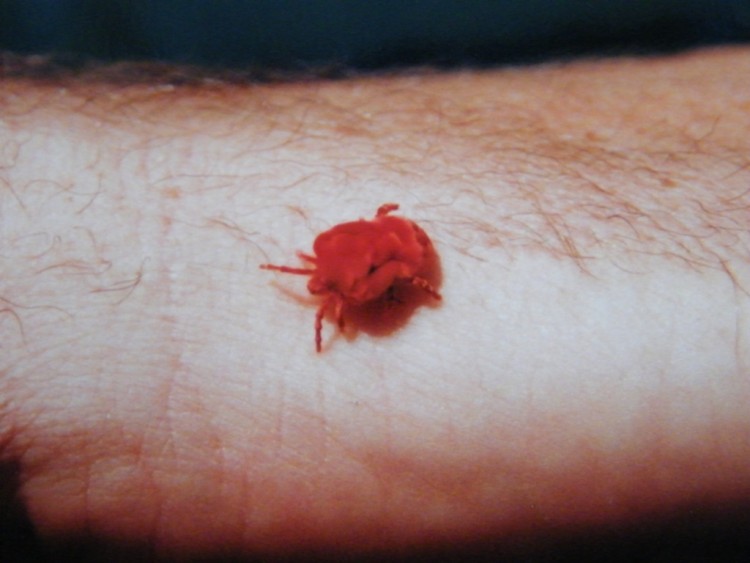Insect or Invertebrates Identification - DONE
Moderator: Klipspringer
- Richprins
- Committee Member
- Posts: 75230
- Joined: Sat May 19, 2012 3:52 pm
- Location: NELSPRUIT
- Contact:
Re: Insect or Invertebrates Identification
Southeast Botswana:

Please check Needs Attention pre-booking: https://africawild-forum.com/viewtopic.php?f=322&t=596
-
Klipspringer
- Global Moderator
- Posts: 5858
- Joined: Sat Sep 14, 2013 12:34 pm
- Country: Germany
- Contact:
Re: Insect or Invertebrates Identification
A Velvet Mite (Family Trombidiidae: Dinothrombium sp.)
Compared with most mites, the brightly red-orange coloured adults of the genus Dinothrombium are among the largest known mites, with
some individuals of the African species exceeding 12 mm in length. The giant velvet mite is covered with a thick red coat of scarlet
hair-like setae. The adults have eight legs but the young hatchlings emerge with six legs, not eight.
They are found in sandy desert areas, in soil, and in soil litter habitats around the world. Adult velvet mites spend most of their lives in subterranean burrows in a diapause-like state waiting for a specific set of ecological conditions triggered by summer rains. On desert soils, adults only emerge to the surface of the sand after heavy rain, and may only forage for a few hours per year. What a comfy lifestyle!
Perhaps you are also interested in their mating rituals :
:
During mating, the male and the female are involved in a “mating dance” during which they encircle each other and tap each other with their
forelegs. The males deposit sperm onto leaves and twigs, and then lay down a trail that leads to them. A female follows the path then “sits” in the sperm. After mating, the female lays as many as 100,000 eggs.
The larvae hatch from eggs, and survive initially as parasites, attaching themselves to insects such as grasshoppers. Once fully fed the six-legged
larva detaches itself and subsequently develops through three eight-legged stages, proto-, deuto- and tritonymph to an adult in the soil. Adults
are predators of small arthropods and their eggs.
Compared with most mites, the brightly red-orange coloured adults of the genus Dinothrombium are among the largest known mites, with
some individuals of the African species exceeding 12 mm in length. The giant velvet mite is covered with a thick red coat of scarlet
hair-like setae. The adults have eight legs but the young hatchlings emerge with six legs, not eight.
They are found in sandy desert areas, in soil, and in soil litter habitats around the world. Adult velvet mites spend most of their lives in subterranean burrows in a diapause-like state waiting for a specific set of ecological conditions triggered by summer rains. On desert soils, adults only emerge to the surface of the sand after heavy rain, and may only forage for a few hours per year. What a comfy lifestyle!
Perhaps you are also interested in their mating rituals
During mating, the male and the female are involved in a “mating dance” during which they encircle each other and tap each other with their
forelegs. The males deposit sperm onto leaves and twigs, and then lay down a trail that leads to them. A female follows the path then “sits” in the sperm. After mating, the female lays as many as 100,000 eggs.
The larvae hatch from eggs, and survive initially as parasites, attaching themselves to insects such as grasshoppers. Once fully fed the six-legged
larva detaches itself and subsequently develops through three eight-legged stages, proto-, deuto- and tritonymph to an adult in the soil. Adults
are predators of small arthropods and their eggs.
- Lisbeth
- Site Admin
- Posts: 65757
- Joined: Sat May 19, 2012 12:31 pm
- Country: Switzerland
- Location: Lugano
- Contact:
Re: Insect or Invertebrates Identification
"Education is the most powerful weapon which you can use to change the world." Nelson Mandela
The desire for equality must never exceed the demands of knowledge
The desire for equality must never exceed the demands of knowledge
- Richprins
- Committee Member
- Posts: 75230
- Joined: Sat May 19, 2012 3:52 pm
- Location: NELSPRUIT
- Contact:
Re: Insect or Invertebrates Identification
A hornymite!
Yes, this thing was big, that is my whole arm there.
And a sandy camp spot under a tree!
Please check Needs Attention pre-booking: https://africawild-forum.com/viewtopic.php?f=322&t=596
-
Klipspringer
- Global Moderator
- Posts: 5858
- Joined: Sat Sep 14, 2013 12:34 pm
- Country: Germany
- Contact:
- nan
- Posts: 26470
- Joined: Thu May 31, 2012 9:41 pm
- Country: Switzerland
- Location: Central Europe
- Contact:
Re: Insect or Invertebrates Identification
I've got one, from the other side 
also a bad picture.. sorry
Kgalagadi 19.1.2016
also a bad picture.. sorry
Kgalagadi 19.1.2016
Kgalagadi lover… for ever
https://safrounet.piwigo.com/
https://safrounet.piwigo.com/
-
Klipspringer
- Global Moderator
- Posts: 5858
- Joined: Sat Sep 14, 2013 12:34 pm
- Country: Germany
- Contact:
- Flutterby
- Posts: 44029
- Joined: Sat May 19, 2012 12:28 pm
- Country: South Africa
- Location: Gauteng, South Africa
- Contact:
Re: Insect or Invertebrates Identification
The Creamy Owl Moths were back again last night and I found this moth in the kitchen.


